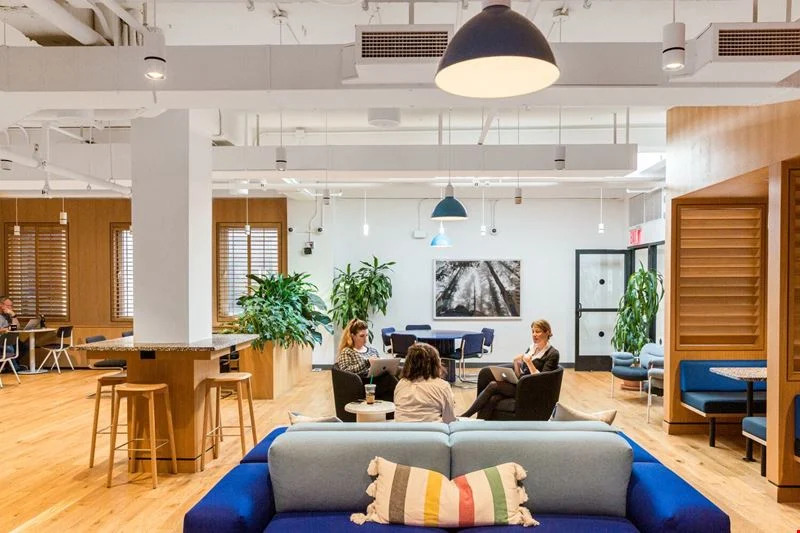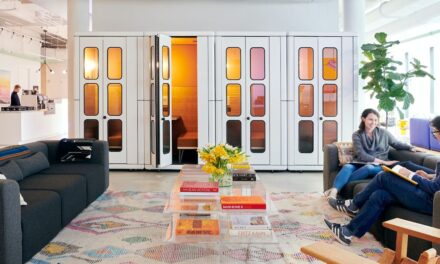With remote and hybrid work becoming the new normal for more and more people around the globe, it’s easy to understand why coworking spaces have become so popular. So much so that research expects the total number of these spaces to reach almost 42,000 worldwide by 2024.
Usually, when we think about coworking spaces, we picture sleek, modern environments and a group of professionals intently working on their laptops and sipping on their teas or coffees.
But what if your job includes liaising with customers or clients and holding face-to-face meetings? When you were based in an office, you could use dedicated onsite facilities, such as boardrooms and conference rooms. These were great ways to make your customers feel at ease in a comfortable yet professional setting.
When transitioning to a coworking space, though, things can change significantly, and finding ways to welcome your customers can become more challenging. That’s why we put together this practical guide with five easy, actionable tips to build a customer-centric coworking space.
Client-Centricity: What It Means and Why It’s Important
Before discussing how to create a client-centric coworking space, it’s essential to have a better understanding of the concept of customer- or client-centricity and its importance. Client-centricity refers to putting clients at the core of all your business operations and striving to craft and deliver exceptional experiences.
Client-centricity matters today for many reasons, including:
– Competitive edge: There might be thousands of companies selling very similar products or services to yours – but do they all truly put the emphasis on their customers? If not, that can become a highly valuable differentiator for you, allowing you to stand out from the crowd.
– Satisfaction, loyalty, and retention: When your operations are underpinned by a culture of customer-centricity, they can become much more personalized, effective, and profitable, resulting in higher customer satisfaction. And when your customers or clients are satisfied, they are much more likely to remain loyal to your brand, which ultimately helps you to keep those all-important retention rates high.
– Solid relationships: As a result of increased satisfaction, loyalty, and retention, client-centricity can lay the foundation for fruitful, long-standing relationships with your customers – both on an individual level and as a community or audience.
Client-centricity, therefore, should be a staple of your broader workplace culture. But how can you incorporate it into your coworking space?

1. Establish Client-Centricity Criteria
Pretty much all your business processes and operations should be monitored and assessed in accordance with specific, pre-defined criteria, from your diversity sourcing strategy to – you guessed it – your client-centric culture.
So, before you start making actual, tangible changes to your coworking space (more on that in a moment), you’ll want to put yourself in your clients’ shoes and ask the question: What about this coworking space would make me feel more at ease when attending a meeting here?
You might identify elements such as a quiet and private meeting area, the availability of light refreshments, or the possibility to attend in-person meetings during less busy times of the day. Once you have zeroed in on what needs to be addressed, you can move on to the next point.
2. Create Client-Focused Spaces
Unlike traditional office space, a coworking setting doesn’t always feature a dedicated area where you can hold conferences or meetings. So, as a member, the choices are essentially three:
1. You carry out your meeting at your desk, with the risk of disturbing your other coworkers and putting off your customer (especially if they need to share any confidential information with you);
2, You switch to a different coworking space that features those collaborative spaces (but this might require time and effort, not to mention that it might end up being more expensive or inconveniently located);
3. You discuss your needs with both the coworking space manager and your other coworkers to find a mutual agreement in terms of dedicating certain areas of the office to client meetings.
As you might expect, the wisest option is the last one. While it wouldn’t be feasible to ask the coworking space community manager to build specific rooms or areas from scratch, you can certainly talk to them about the possibility of adding some features that might make the space more client-friendly.
Such things might include a panel to separate the main office area from the meeting area, the addition of some pieces of furniture for your client’s comfort, and the provision of light refreshments. Bear in mind that any substantial changes and improvements may come at a cost to both you and your coworkers, so ensure that you are all on board and happy to go ahead.
3. Ensure Top-Notch Communication With Your Coworkers
One of the beauties of coworking spaces is that they bring together many different types of professionals – from the digital nomad working for a tech startup that develops college recruiting software to the seasoned eCommerce specialist running a small but thriving online store.
Imagine the chaos if every one of them brought in their clients for chats and meetings simultaneously. Not only would it look extremely unprofessional and off-putting, but it would also severely hamper communication.
How can you make sure that this never happens? Well, think again about what you used to do – or would do – when you were sharing an office with colleagues from your company. In all likelihood, you had shared calendar views as well as room-booking systems to ensure that meetings wouldn’t clash and that people had enough time to carry out presentations and other important tasks.
You’ll want to implement a similar system at your current coworking space. While expecting other people to grant you access to their calendar is not an option, you can create a channel or thread on a collaboration and communication platform like Slack, where every coworking space member adds the dates and times of their face-to-face meetings.
Prefer to go down a more traditional route? Equip your coworking space with a whiteboard and have everyone write down when they might need to use a specific area of the office for their meeting.
4. Implement the Right Tech
We’ve just mentioned leveraging a shared communication and collaboration platform where you and your coworkers keep track of your face-to-face customer meetings, but that’s not the only tech tool to consider implementing to make your coworking space more client-focused.
You could go even further and use dedicated coworking software tools that help you better manage and use the available spaces at your coworking office. For example, there are plenty of desk-booking and room-booking apps and digital tools that can enable you – and your coworkers – to secure a spot in the office for a specific date and time (aka, when your client is visiting).
But technology can do even more, such as making your coworking space more sustainable. To this end, you may want to speak with your coworking space provider and enquire about the possibility of adding eco-friendly features to the office, such as recycling stations and reusable/refillable equipment (especially in the kitchen area, more energy-efficient equipment, such as lighting, fridges, kettles, and microwaves, and indoor plants and greenery.
A more sustainable coworking space is likely to have a lasting, favorable impact on the people who visit you there, which means they won’t miss meeting you at your old office while also showcasing your genuine commitment to being more environmentally friendly.

5. Ask for Regular Feedback
So, you’ve taken all – or some – of the actions above to make your coworking space more client-centric, but how do you know for sure whether all your effort has paid off? It’s simple: ask!
Create surveys and questionnaires for your customers to fill in after they have visited you at your coworking space, and include questions such as:
– How did you find the meeting location? Was it what you were expecting, or did it lack something?
– Were you happy with the journey to the meeting location, or did it require a long and inconvenient commute?
– How satisfied were you with the privacy of the location? Did you feel comfortable discussing confidential information in that setting
– Did you take advantage of any other amenities of the coworking space, such as the available refreshments?
Doing so shows your clients or customers that you truly care about them, their opinions, and their satisfaction – which makes you a full-fledged client-centric operation.
Key Takeaways
Just because you now work in a coworking space, it doesn’t mean you can’t – or shouldn’t – have over for a visit or hold an important meeting with a potential client. The trick is to make those spaces more client-centric.
As we have seen in our guide, building a client-centric coworking space requires the collaboration and support of a range of people, including your coworkers and your coworking space manager or provider. Once you have gained this, you can start gradually implementing the easy yet effective changes we talked about in our guide to ensure that your customers always feel at ease and comfortable in your coworking space.
And remember: the best way to work out if you’re on the right track is to ask your customers directly, so don’t forget to send out those all-important surveys after they have visited you at your coworking space!









